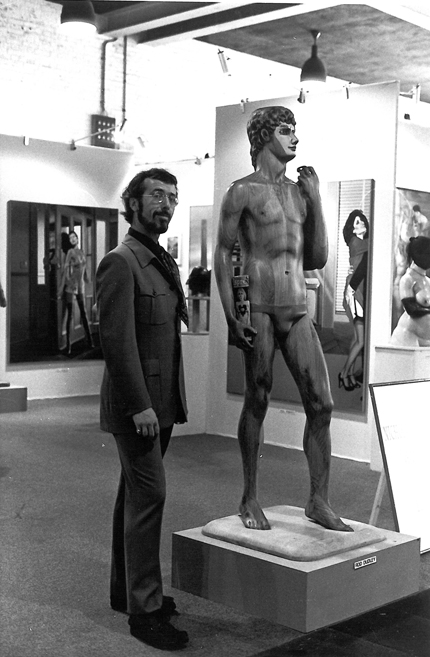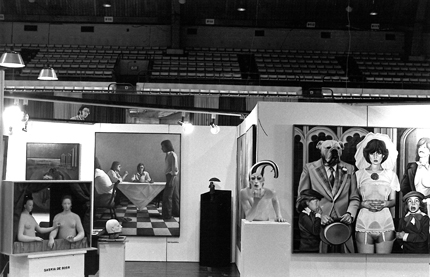Superhumanism – the background.
The first book of Superhumanism, published in 1979, quickly sold out of five thousand copies. It was followed in 1982 by Superhumanism 2, to coincide with a New York Superhumanism Exhibition. The published ten thousand copies were again sold out within three years. These books can still be found on Amazon or other internet book websites.
 Basel Art Fair 1975, with Rod Dudley`s “Statue of David”
Basel Art Fair 1975, with Rod Dudley`s “Statue of David”
Superhumanism
It was the stimulating mood and social changes of the significant sixties decade that laid the foundations of the Superhumanist movement. I arrived in the art world in the early part of that decade with an open mind, but little knowledge of art. I had no real idea of what to expect from contemporary art. I didn`t check out what other galleries were doing, but trusted my instincts in what I wanted to put on show. Some breaking down of the British class structure meant that young people from the former working classes were suddenly having the opportunity for subsidised art education. I noticed that most of the artist in whom I was interested came from this strata of society. They were not inhibited by middle class taste values, and in their art they responded instinctively to what was going on around them with contemporary vitality. I personally found the emerging alternative art exciting and relevant to us all. Often it exploited Tabu subject matter, often it depicted aspects of life generally considered in bad taste or honestly vulgar. Frequently it provoked dismissive criticism. Recognising that much of life could be seen to be in bad taste , and the art was simply reflecting it, I did not see such criticism as valid. I persisted in developing my gallery`s provocative style. Through the sixties and into the seventies, the country became more democratic, and equal rights became a much discussed issue. There were the beginnings of the forthcoming powerful 1970´s Feminist movement. There was a vast increase in the number of female art students, and they particularly explored alternative materials, and more intimate and personal subject matter. However, within the confines of the male controlled art world, it was still Middle/Upper Class values which ruled as regards to the judgement of what was or wasn`t “Great” art.
The mood of the sixties encouraged a counter-culture, fuelled by youthful rebellion (Sex and Drugs and Rock and Roll) which eventually almost fizzled out as the realities of the market place and the early seventies recession brought the majority of people down to earth. For the most part, Art galleries remained precious white boxes in the most exclusive shopping areas of the city. They had the forbidding and hushed atmosphere of a church, and what was on exhibition was generally tasteful and comparatively expensive. These were not the kind of places in which artists themselves felt in any way comfortable. I wanted my gallery to be London`s friendliest. I wanted everyone to feel at home in it, particularly the artists. I was determined to attract a new public to art, and the works exhibited in the gallery`s window always attempted to make passers by feel it`s friendliness, by making them laugh, or even shudder. The interior had comfy seats on which you could sit and chat or drink coffee. It`s location in Chiltern Street, a modest central London street, leading nowhere, with three storeys of upstairs flats and a number of useful shops, was considered the wrong part of town for a successful gallery. The fact that I lived in one of the gallery`s basement rooms for twelve years, helped to give it`s series of awkward little spaces an unpretentious and homely feel. Artists got in the habit of using it to sleep overnight when we were having a night out together. It was really more of a meeting place than a thriving commercial gallery. 36, Chiltern Street, London W1, which I occupied from 1968 to 1984 was seminal in the development of Superhumanism.
 The Washington Art Fair 1978, with works by Saskia de Boer, Guy Gladwell, John Buckley and Eric Scott.
The Washington Art Fair 1978, with works by Saskia de Boer, Guy Gladwell, John Buckley and Eric Scott.
In essence, Superhumanism is the first people`s art movement – a movement, first and foremost, inspired by life, as opposed to inspired by art. It is a movement of art by the people, for the people, and about the people. It is about tolerance and human understanding. Initially, a Superhumanist work will move you to feel – to laugh, to cry, to shudder, to be overwhelmed with compassion. They do not include any aesthetic gesture to distract from the vivid nature of the image. A Superhumanist work will take a down to earth subject, and use original technical means to exaggerate it, achieving an over-the-top impact of it`s humanist theme.
The point is, it is not possible to manufacture an authentic art movement. They just happen in extraordinary circumstances. Naturally, there needs to be a focussing location and my gallery had the appropriate relaxed and informal atmosphere. It was like the family home of a group of creative people from diverse but similar backgrounds, over a socially significant seventeen year period of time. The associated artists were all born during the second world war, or five to ten years either side of it, and had an equivalent art education. They were a particularly bloody-minded group of talented people, who, whatever else they thought of me, trusted me and my good intentions. They inter-acted with me with equal measures of irritation and warmth, and suffered other artists with both friendship and enmity. They stuck with me for long enough to see, by the late seventies, the emergence of the most individually inspired related humanist art of the late twentieth century.
nicholas treadwell, 2010.